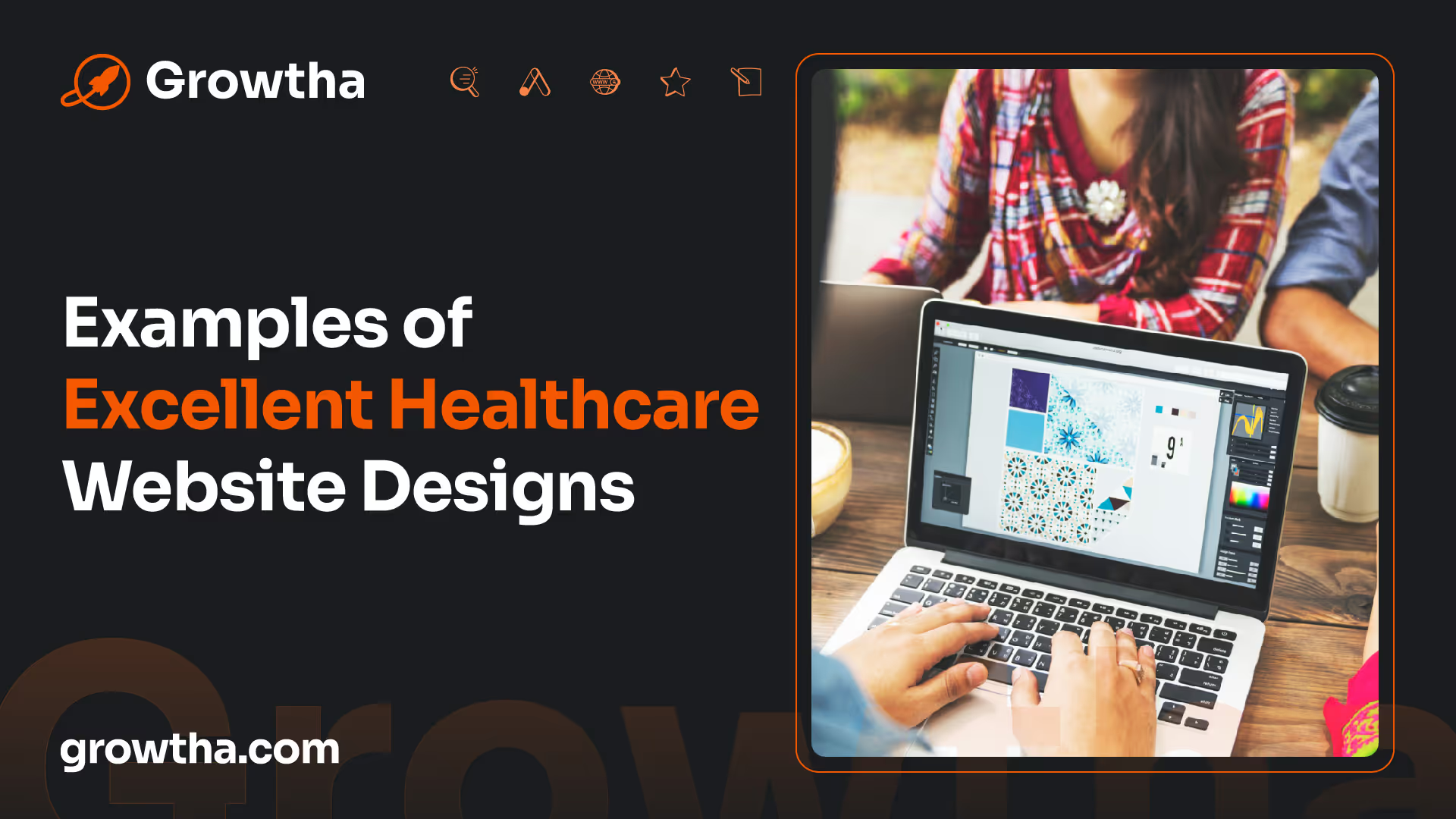The 10 Best Healthcare Website Design Examples
The design of a healthcare website plays a vital role in enhancing user experience and increasing patient engagement.


The 10 Best Healthcare Website Design Examples
The Importance of Healthcare Website Design
In today's digital age, having a well-designed healthcare website is essential for healthcare providers to effectively connect with their audience and provide valuable information. The design of a healthcare website plays a vital role in enhancing user experience and increasing patient engagement.
Enhancing User Experience
A good healthcare website design focuses on various elements to enhance user experience. User-friendly navigation is key, allowing visitors to easily find the information they need. Intuitive search functions and well-organized menus enable users to navigate the website effortlessly. By providing a seamless browsing experience, healthcare websites can keep users engaged and encourage them to explore further [1].
Engaging visuals are another crucial aspect of healthcare website design. High-quality images, videos, and infographics can effectively convey information and capture the attention of visitors. Visuals can help simplify complex medical concepts, making them more accessible and understandable. By incorporating engaging visuals, healthcare websites can create a visually appealing and informative experience for users [2].
Increasing Patient Engagement
Patient engagement is vital for healthcare providers to establish strong relationships with their patients. Effective healthcare website design can play a significant role in increasing patient engagement. Clear and prominent calls-to-action (CTAs) strategically placed throughout the website can encourage visitors to take desired actions, such as scheduling appointments, subscribing to newsletters, or contacting the healthcare provider [2]. These CTAs provide a clear pathway for users to engage with the healthcare provider and take the next steps in their healthcare journey.
Incorporating patient testimonials, reviews, and success stories on healthcare websites can also enhance patient engagement. By showcasing positive experiences and outcomes, healthcare providers can establish credibility, build trust with potential patients, and showcase the quality of services they offer. Patient testimonials can help potential patients feel more confident and comfortable in their decision to seek care from a particular healthcare provider [2].
By prioritizing user experience and patient engagement in healthcare website design, healthcare providers can effectively connect with their audience, provide valuable information, and foster meaningful relationships with their patients. A well-designed website not only enhances the online presence of healthcare providers but also contributes to improving overall patient satisfaction and outcomes.

Examples of Excellent Healthcare Website Designs
When it comes to healthcare website design, there are several exemplary websites that stand out for their user-friendly interfaces, engaging visuals, and effective communication of information. Here are five examples of healthcare websites that excel in design:
MyMenopauseJourney.com
MyMenopauseJourney.com is a website that showcases a clean and professional design, offering users resources such as a symptom checker and a navigation panel to easily access information on menopause. The website's intuitive layout and user-friendly features make it a valuable resource for individuals navigating the challenges of menopause.
SkinCancer.org
Bold images and colors are utilized on SkinCancer.org, creating an engaging and informative website dedicated to skin cancer prevention, detection, and treatment. The website serves as a comprehensive information hub, providing users with valuable resources to educate themselves about skin cancer and take proactive steps for prevention.
Stanfordchildrens.org
Stanfordchildrens.org is highlighted for its user-friendly navigation, clear call-to-action buttons, and engaging visuals, making it an excellent example of a healthcare website design focused on children's health. The website provides a seamless experience for parents and caregivers, offering essential information about pediatric healthcare services, resources, and patient care.
MountSinai.org
The website for MountSinai.org boasts a modern design, seamless navigation, and integration of patient education resources, enhancing the overall user experience. The website's clean layout and intuitive organization make it easy for visitors to find the information they need about healthcare services, medical research, and patient care options.
ClevelandClinic.org
ClevelandClinic.org is cited as a top healthcare website design due to its emphasis on patient stories, easy access to appointment scheduling, and a clear layout that prioritizes user needs. The website effectively combines informative content with a user-friendly interface, ensuring that patients can easily navigate the site to find the information they seek.
These examples of excellent healthcare website designs demonstrate the importance of user-centric design, clear navigation, and engaging visuals. By incorporating these elements into their websites, healthcare organizations can enhance the user experience, increase patient engagement, and effectively communicate important information to their audience.
Key Features of Effective Healthcare Website Design
Creating a successful healthcare website requires careful consideration of key design elements that enhance user experience and engagement. Here are three key features that contribute to effective healthcare website design:
User-Friendly Navigation
A user-friendly navigation system is essential for healthcare websites. Visitors should be able to easily find the information they need without confusion or frustration. Clear and intuitive navigation menus, drop-down menus, and search functionalities can greatly enhance the user experience.
To optimize navigation, healthcare websites should organize content into logical categories and subcategories. This allows users to navigate through different sections of the website effortlessly. Additionally, incorporating breadcrumb trails or a sitemap can provide users with a visual representation of their location within the website hierarchy.
Clear Call-to-Action Buttons
Clear and prominent call-to-action (CTA) buttons are vital to guide users towards desired actions on a healthcare website. CTAs can include buttons for scheduling appointments, accessing patient portals, subscribing to newsletters, or requesting more information.
Effective CTAs are visually distinct, using contrasting colors and clear text to grab users' attention. The language used in CTAs should be concise, action-oriented, and communicate the value proposition to the user. For example, instead of a generic "Submit" button, a more compelling CTA could be "Book Your Appointment Now" or "Get Your Free Consultation."
Engaging Visuals
Engaging visuals play a crucial role in capturing users' attention and creating a positive impression. High-quality images, videos, and graphics can convey information, evoke emotions, and enhance the overall aesthetics of a healthcare website.
Visuals should align with the website's purpose and target audience. For instance, a website focusing on children's health may incorporate colorful and playful illustrations, while a website for a dermatology clinic could include images showcasing healthy skin and the effects of various skin conditions.
It's important to optimize visuals to ensure fast loading times without compromising quality. Compressing images, using appropriate file formats, and implementing lazy loading techniques can help maintain a balance between visual appeal and website performance.
By incorporating user-friendly navigation, clear call-to-action buttons, and engaging visuals, healthcare websites can create a positive user experience and effectively engage visitors. These key features contribute to the overall success of a healthcare website by providing valuable information, promoting patient engagement, and facilitating access to healthcare services.

Best Practices for Mobile Optimization of Healthcare Websites
In today's digital age, optimizing healthcare websites for mobile devices is essential. With the increasing use of smartphones and tablets, having a mobile-friendly website is crucial to provide an optimal user experience and ensure that patients can easily access the information they need. Let's explore some best practices for mobile optimization of healthcare websites.
Importance of Mobile Optimization
Mobile optimization plays a significant role in improving user experience, increasing accessibility, and enhancing patient engagement. Having a mobile-friendly healthcare website offers several benefits, including:
- Improved User Experience: A responsive and mobile-optimized website ensures that patients can navigate, read content, and interact with the site seamlessly on their mobile devices, leading to a positive user experience.
- Increased Accessibility: Mobile optimization makes healthcare information readily available to patients on the go, allowing them to access important details, schedule appointments, and communicate with healthcare providers conveniently.
- Enhanced Patient Engagement: By providing a mobile-friendly experience, healthcare websites can engage patients effectively, encouraging them to explore different sections of the site, access educational resources, and actively participate in their healthcare journey.
On the flip side, poor mobile optimization can result in high bounce rates, subpar user experience, and lower search engine rankings. To avoid these consequences, healthcare websites should adhere to best practices for mobile optimization.
Responsive Design
One of the primary best practices for optimizing healthcare websites for mobile users is utilizing responsive design. Responsive design allows the website to adapt and adjust its layout based on the screen size and orientation of the device being used. This ensures that the website appears well-structured and visually appealing across various devices, including smartphones and tablets.
By implementing responsive design, healthcare websites can provide a consistent user experience regardless of the device being used. Buttons, menus, and content are appropriately resized and rearranged to fit smaller screens, maintaining usability and readability.
Optimizing Images and Content
Optimizing images and streamlining content are crucial aspects of mobile optimization for healthcare websites. Large, high-resolution images can slow down page loading times and consume significant data for mobile users. It's important to compress images without compromising their quality to ensure fast loading times and a smooth browsing experience.
Additionally, content should be tailored for mobile users. Lengthy paragraphs should be broken down into shorter, concise sections, making it easier for users to scan and digest information. Utilizing bullet points, subheadings, and lists can help improve readability on smaller screens.
Clear Calls-to-Action
Clear and prominent calls-to-action (CTAs) are essential for mobile optimization. CTAs guide users to take specific actions, such as scheduling appointments, accessing patient portals, or contacting healthcare providers. It's crucial to make CTAs visually distinct, easily clickable, and strategically placed within the mobile interface. This ensures that users can quickly and intuitively navigate through the website and take the desired actions.
By incorporating these best practices for mobile optimization, healthcare websites can provide an exceptional user experience, increase patient engagement, and ensure that vital healthcare information is accessible to patients wherever they are. Furthermore, healthcare websites should prioritize data security by implementing secure forms to protect patient information and maintain confidentiality.
Incorporating Innovative Trends in Healthcare Website Design
To stay ahead in the ever-evolving digital landscape, healthcare websites need to incorporate innovative trends to enhance user experience and engagement. In this section, we will explore three key trends in healthcare website design: chatbots for enhanced interaction, utilizing high-quality visuals, and clear calls-to-action.
Chatbots for Enhanced Interaction
Incorporating chatbots on healthcare websites can revolutionize the way users interact with the site. Chatbots provide instant responses to common queries and guide visitors through the website efficiently. They can assist users in finding relevant information, scheduling appointments, or even answering basic medical questions [2].
By implementing chatbots, healthcare websites can provide personalized support 24/7, enhancing user experience and engagement. Visitors can receive immediate assistance, improving their overall satisfaction with the website and the healthcare provider.
Utilizing High-Quality Visuals
The use of high-quality images, videos, and infographics on healthcare websites can significantly impact user engagement and create an immersive visual experience. Visuals help convey complex medical information in a visually appealing and understandable manner. They can showcase medical procedures, highlight the expertise of healthcare professionals, and provide a glimpse into the facilities and services offered.
By utilizing captivating visuals, healthcare websites can effectively communicate with their audience and build trust. High-quality visuals can also contribute to the overall aesthetics of the website, making it more appealing and memorable for visitors.
Clear Calls-to-Action
Clear and prominent calls-to-action (CTAs) play a crucial role in guiding visitors to take desired actions on healthcare websites. Whether it's scheduling an appointment, subscribing to newsletters, or contacting the healthcare provider, CTAs help improve user engagement and conversion rates.
By strategically placing CTAs throughout the website, healthcare providers can encourage visitors to take action. It's important to make the CTAs visually distinct, using colors that stand out and compelling text to motivate users to click. Additionally, incorporating patient testimonials, reviews, and success stories alongside the CTAs can establish credibility and build trust with potential patients.
By incorporating these innovative trends in healthcare website design, healthcare providers can create user-friendly, visually appealing, and engaging websites. These trends enhance user interaction, build trust, and ultimately contribute to the success of the healthcare organization in the digital realm.
Ensuring Compliance and Security in Healthcare Website Design
When it comes to healthcare website design, ensuring compliance and security is of utmost importance. Healthcare websites handle sensitive patient information, and it is crucial to maintain privacy, protect patient data, and comply with regulations such as the Health Insurance Portability and Accountability Act (HIPAA).
HIPAA Compliance
HIPAA compliance is a critical aspect of healthcare website design. It establishes guidelines and regulations to protect patient privacy and safeguard their health information. Healthcare websites must adhere to HIPAA rules and regulations to protect against unauthorized access, data breaches, and maintain the confidentiality and security of patient data [3].
Protecting Patient Data
Protecting patient data is a top priority for healthcare websites. Implementing robust security measures, such as encryption protocols and secure data storage, is essential to prevent unauthorized access to sensitive information. Regular security audits and updates are necessary to mitigate vulnerabilities and ensure the utmost protection of patient data [4].
Secure Forms and Patient Portals
As part of the best practices for mobile optimization, healthcare websites should prioritize secure forms. This includes implementing SSL certificates, which encrypt data transmitted between the user's device and the website server, protecting patient information from interception.
In addition, healthcare websites can enhance user experience and ensure security by incorporating patient portals. These secure online platforms allow patients to access their medical records, schedule appointments, and communicate with healthcare providers. Implementing secure authentication methods and robust user access controls ensure that only authorized individuals can access sensitive patient information.
By prioritizing HIPAA compliance, protecting patient data, and implementing secure forms and patient portals, healthcare websites can maintain the trust and confidence of patients while safeguarding their sensitive information. It is essential for healthcare organizations to work closely with web developers and security experts to ensure that their websites meet the highest standards of compliance and security.
References
[1]: https://digitalismedical.com/blog/healthcare-website-design-trends/
[2]: https://www.janbaskdigitaldesign.com/blogs/healthcare-website-design-trends/
[3]: https://www.clarity-ventures.com/services/hipaa-compliant-websites
[4]: https://kanopi.com/blog/healthcare-website-design/
[5]: https://quickcreator.io/articles/mobile-optimization-healthcare-websites1/







